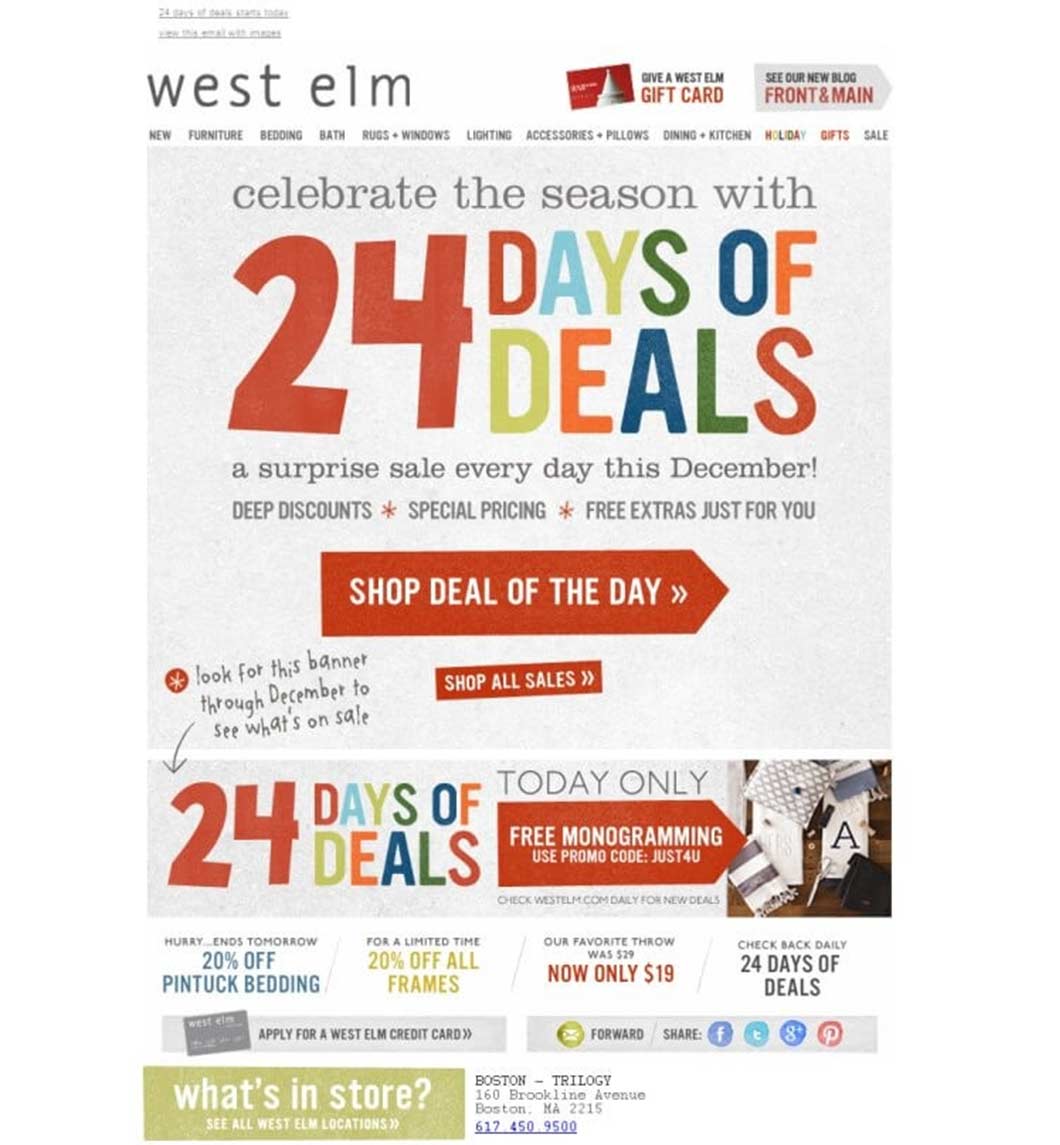The holiday season offers an opportunity to attract customers and increase profits for small businesses.
Consider that Black Friday, Cyber Monday and Small Business Saturday have typically led to record-breaking sales.
Cyber Monday generated $10.7 billion in 2021, making it the biggest online shopping day, according to Adobe Analytics. Black Friday came in second, with online spending reaching $8.9 billion. Likewise, 58% of Small Business Saturday shoppers reported they purchased online from a small business on the day, according to American Express.
These statistics may be astounding, but don’t expect to magically attract more customers on the day itself. If you want to benefit from the hype, you need to plan ahead of time.
Let us help you prepare by sharing the most common tips to ace small business holiday sales.
1. Set Plans and Seasonal Goals
Create a robust sales and holiday retail marketing strategy.
Begin by reviewing the results from previous holiday sales. Identify top-selling products and use this information to decide on deals and inventory.
Similar to marketing or sales campaigns, set realistic and attainable goals. Don’t focus solely on revenue. Consider other metrics, such as social media engagement, conversion rate, customer lifetime value and return on investment. While some of these metrics might not directly translate into profit, it’s still important to increase brand awareness and engagement with your target audience.
In addition, invest in analytics tools to monitor metrics for current and future holiday sales initiatives. You also should monitor the holiday marketing and sales strategy of your competitors. If their previous holiday promotions led to a lot of fanfare, then adopt it in your strategy too.
2. Order Extra Stock
You’ll likely have less flexibility a few weeks leading up to your small business holiday sale. As many businesses scramble to get more stock, it could be difficult to replenish your inventory for on-demand items.
Losing customers because of sold-out products can be devastating, so determine the amount of stock you need. Take note of best-selling products or trending goods and order extra quantities. Ordering in bulk also gives you an opportunity to negotiate with vendors for additional discounts.
3. Secure Sufficient Working Capital
Before the holiday season, small businesses may need extra cash to replenish their stock and update inventory, which can substantially decrease working capital. Also, setting aside funds for payroll and holiday bonuses is another common need that can affect cash flow.
The good news is, securing sufficient working capital ahead of time can help you afford new stock and cover other holiday expenses. With enough time on your side, you can shop around for the best rates and terms to avoid a last-minute financing crunch.
4. Avoid Credit Processing Limits
Small businesses may have credit processing limits as stipulated by their merchant accounts. To accommodate all holiday transactions, get in touch with payment processors to arrange higher credit limits. There’s nothing worse than failing to process credit card transactions during the biggest shopping event of the year.
5. Market Products to Loyal Customers
Maximize revenue by focusing on your loyal customers. Ultimately, the chances of selling something to an existing customer are 60%-70%, while the chances of selling to a new customer drop to 5%-20%, according to conversion rate optimization company Invesp. That’s because loyal shoppers already trust your business and are typically more receptive to your marketing efforts, while new customers tend to be more skeptical.
So when marketing to your loyal customers, consider creating email marketing campaigns promoting gift guides, sending personalized discounts and bolstering awareness for online sales. Additionally, leverage the purchase history of existing customers and use it to send personalized product recommendations or exclusive offers.
If you offer a loyalty program, revamp your current incentives to encourage shoppers to use their points and make more purchases.
Related: Customer Loyalty Statistics
6. Create an Editorial Schedule
Content is king, but this is especially true during the holiday season.
To generate awareness for your sales event, create social media posts, publish blog posts and upload video content.
The thing is, content creators, copywriters and graphic designers won’t come up with holiday promotion ideas on the fly. Marketing teams may need weeks or months to prepare content.
Create an editorial calendar to guarantee you’ll have ample content to reinforce your sales strategy. If you want to collaborate with influencers, reach out months before to iron out the details and negotiate rates. Then, as the holiday season approaches, modify your calendar and check up on deliverables to guarantee everyone on the team is on track.
For example, West Elm’s “24 Days of Deals” campaign featured limited-time offers to incite urgency. While this could be an effective way to attract publicity, it also requires planning ahead.

7. Optimize Your Online Store
Holiday sales will attract more traffic to your store, but is your website capable enough to handle it?
Before the onslaught of customers, optimize your website and fix bugs. Peak small business holidays, such as Black Friday, can attract upward of 3 times more traffic than usual, so make sure your website can handle the increase in visitors.
After all, about 25% of small businesses estimate the per-hour cost of downtime is roughly $20,000 to $40,000, while 26% believe the loss could amount to $10,000 to $20,000 per hour. However, the losses may be greater if downtime happens during holiday sales.
For instance, Gymshark crashed for 8 hours during Black Friday. As a result, the fitness apparel and accessories brand estimates it lost £100,000 (about $137,000) in sales.
Additionally, if your site lacks security, you could risk sensitive customer data and put customers at risk for fraud. Minimize this potential by using end-to-end encryption and conducting security checks, following payment card industry compliance regulations set forth by the PCI Security Standards Council.
8. Update Order Policies
Holiday sales give you an opportunity to attract new shoppers to your online store. So how do you encourage them to make a purchase?
Update your order policy. Offer free or discounted shipping to incentivize first-time buyers. Or add a special gift or freebies to make it more enticing.
For example, the online printing service Smartpress offers free paper sample books as a part of its onboarding process. Free samples are a compelling incentive to convince potential customers to try a service.

9. Provide Exceptional Customer Service
The pandemic led to a massive shift to online and ecommerce channels, but plenty of shoppers still prefer online shopping for its speed and convenience.
For a seamless shopping experience, train sales agents and support staff to efficiently address complaints. If you think you’ll be short-staffed on the holiday itself, outsource sales reps to accommodate the onslaught of customers.
10. Offer Competitive Shipping Options
Customers want packages to arrive quickly, especially during the end-of-year holidays. Most of the items bought could be gifts for loved ones so they must arrive on time.
Since holiday sales mean many more orders, assess your shipping and delivery process. List the steps involved in your shipping or fulfillment process and evaluate whether it’s still relevant during the peak season.
At the same time, recall how long it takes to complete each step and look for potential bottlenecks. Maybe you can save time by purchasing and printing multiple shipping labels in bulk. Fast-growing businesses can get in touch with a third-party logistics company for shipping and warehousing needs.
Speeding up the shipping and fulfillment process by a few minutes may not seem significant. However, it will make a difference when you’re handling dozens or hundreds of orders in a day.
In addition, brick-and-mortar stores can tap into local delivery service options within their community to speed up service. Contemplate having an in-store pickup option that lets local customers save on shipping costs.
They say opportunities come to those who are prepared. So, if you want to make the most out of the holiday season, devising a strategy ahead of time will be the key to success.











